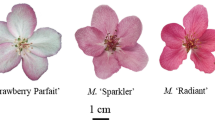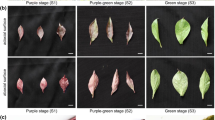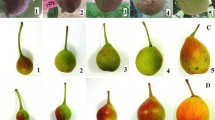Abstract
Paeonia suffruticosa ‘Shima Nishiki’ is a very precious double-color cultivar because of its distinctive and colorful flowers. However, our understanding of the underlying mechanisms of its double-color formation is limited. The present study investigated the soluble sugar content, cell sap pH value and anatomical structure, anthocyanin composition and content and expression patterns of genes related to anthocyanin biosynthesis in the red and pink petals of the ‘Shima Nishiki’ cultivar. Here, we found that soluble sugar content, cell sap pH and the shape of outer epidermal cells were not the key factors that determine double-color formation. Five different anthocyanins were detected in both the red and pink petals, and the pelargonidin-3,5-di-O-glucoside (Pg3G5G) and pelargonidin-3-O-glucoside (Pg3G) contents in the red petals were significantly higher than those in the pink petals at every developmental stage. In addition, these gene expression patterns suggested that the significant differential expression of the dihydroflavonol 4-reductase gene (PsDFR) gene might play a key role in double-color formation. These results will provide a valuable resource for further studies unraveling the underlying genetic mechanisms of double-color formation in P. suffruticosa ‘Shima Nishiki’.





Similar content being viewed by others
References
Chen YN, Mao Y, Liu HL, Yu FX, Li SX, Yin TM (2014) Transcriptome analysis of differentially expressed genes relevant to variegation in peach flowers. PLoS One 9:e90842
Davies KM, Albert NW, Schwinn KE (2012) From landing lights to mimicry: the molecular regulation of flower coloration and mechanisms for pigmentation patterning. Funct Plant Biol 39:619–638
Fan JL, Zhu WX, Shen JW, Ma HL (2009) Determination of the contents of anthocyanins and flavonols in petals of red flowered cultivars of Zhongyuan tree peony. North Hortic 10:191–194 (in Chinese)
Gao LX, Yang HX, Liu HF, Yang J, Hu YH (2016) Transcriptome changes underlying the flower color intensity variation in Paeonia ostii. Front Plant Sci 6:1205
Grotewold E (2006) The genetics and biochemistry of floral pigments. Annu Rev Plant Biol 57:761–780
Guo WW, Dong L, Wang LY, Chen RX, Liu AQ (2004) The postharvest characteristics and water balance of some cultivars of tree-peony cut flowers. Sci Silvae Sin 40:89–93 (in Chinese)
He QL, Shen Y, Wang MX, Huang MR, Yang RZ, Zhu SJ, Wang LS, Xu YJ, Wu RL (2011) Natural variation in petal color in Lycoris longituba revealed by anthocyanin components. PLoS One 6:e22098
Hosoki T, Hamada M, Kando T, Moriwaki R, Inaba K (1991) Comparative study of anthocyanins in tree peony flowers. J Jpn Soc Hortic Sci 60:395–403
Ji LJ, Wang Q, da Silva JAT, Yu XN (2012) The genetic diversity of Paeonia L. Sci Hortic 143:62–74
Kim DH, Park S, Lee JY, Ha SH, Lim SH (2018) Enhancing flower color through simultaneous expression of the B-peru and mPAP1 transcription factors under control of a flower-specific promoter. Int J Mol Sci 19:309
Li CH, Wang LS, Shu YQ, Xu YJ, Zhang J (2008) Pigments composition of petals and floral color change during the blooming period in Rhododendron mucronulatum. Acta Hortic Sin 35:1023–1030 (in Chinese)
Lim SH, Kim JK, Kim DH, Sohn SH, Lee JY, Kim YM, Ha SH (2011) Flower color modification by manipulating flavonoid biosynthetic pathway. Kor J Hort Sci Technol 29:511–522
Nakatsuka T, Nishihara M, Mishiba K, Yamamura S (2005) Temporal expression of flavonoid biosynthesis—related genes regulates flower pigmentation in gentian plants. Plant Sci 168:1309–1318
Nakatsuka A, Hitomi M, Tsuma M, Ito A, Mizuta D, Kobayashi N (2015) Effect of anthocyanin profile and petal pH on flower coloration in evergreen azalea. Acta Hortic 48:357–362
Nishihara M, Nakatsuka T (2011) Genetic engineering of flavonoid pigments to modify flower color in floricultural plants. Biotechnol Lett 33:433–441
Noda K, Glover BJ, Linstead P, Martin C (1994) Flower color intensity depends on specialized cell shape controlled by a Myb–related transcription factor. Nature 369:661–664
Noman A, Aqeel M, Deng JM, Khalid N, Sanaullah T, Shuilin H (2017) Biotechnological advancements for improving floral attributes in ornamental plants. Front Plant Sci 8:530
Quintana A, Albrechtová J, Griesbach RJ, Freyre R (2007) Anatomical and biochemical studies of anthocyanidins in flowers of Anagallis monelli L. (Primulaceae) hybrids. Sci Hortic 112:413–421
Sakata Y, Aoki N, Tsunematsu S, Nishikouri H, Johjima T (1995) Petal coloration and pigmentation of tree peony bred and selected in Daikon Island (Shimane Prefecture). J Jpn Soc Hortic Sci 64:351–357
Schmittgen TD, Livak KJ (2008) Analyzing real-time PCR data by the comparative CT method. Nat Protoc 3:1101–1108
Schmitzer V, Veberic R, Osterc G, Stampar F (2010) Color and phenolic content changes during flower development in groundcover Rose. J Am Soc Hortic Sci 135:195–202
Shi SG, Yang M, Zhang M, Wang P, Kang YX, Liu JJ (2014) Genome-wide transcriptome analysis of genes involved in flavonoid biosynthesis between red and white strains of Magnolia sprengeri pamp. BMC Genom 15:706
Shi QQ, Zhou L, Wang Y, Li K, Zheng BQ, Miao K (2015) Transcriptomic analysis of Paeonia delavayi wild population flowers to identify differentially expressed genes involved in purple-red and yellow petal pigmentation. PLoS One 10:e0135038
Stabentheiner E, Zankel A, Pölt P (2010) Environmental scanning electron microscopy(ESEM)—a versatile tool in studying plants. Protoplasma 246:89–99
Stewart RN, Norris KH, Asen S (1975) Microspectrophotometric measurement of pH and pH effect on color of petal epidermal cells. Phytochemistry 14:937–942
Wang LS, Shiraishi A, Hashimoto F, Aoki N, Shimizu K, Sakata Y (2001) Analysis of petal anthocyanins to investigate flower coloration of Zhongyuan (Chinese) and Daikon Island (Japanese) tree peony cultivars. J Plant Res 114:33–43
Weiss D (2000) Regulation of flower pigmentation and growth: multiple signaling pathways control anthocyanin synthesis in expanding petals. Physiol Plant 110:152–157
Yang Q, Yuan T, Sun XB (2015) Preliminary studies on the changes of flower color during the flowering period in two tree peony cultivars. Acta Hortic Sin 42:930–938
Zhang JJ, Wang LS, Shu QY, Liu ZA, Li CH, Zhang J, Wei XL, Tian DK (2007) Comparison of anthocyanins in non–blotches and blotches of the petals of Xibei tree peony. Sci Hortic 114:104–111
Zhang C, Wang WN, Wang YJ, Gao SL, Du DN, Fu JX, Dong L (2014) Anthocyanin biosynthesis and accumulation in developing flowers of tree peony (Paeonia suffruticosa) ‘Luoyang Hong’. Postharvest Biol Technol 97:11–22
Zhang C, Fu JX, Wang YJ, Gao SL, Du DN, Wu F, Guo J, Dong L (2015a) Glucose supply improves petal coloration and anthocyanin biosynthesis in Paeonia suffruticosa ‘Luoyang Hong’ cut flowers. Postharvest Biol Technol 101:73–81
Zhang YX, Zhan L, Gai SP, Liu CY, Lu S (2015b) Cloning and expression analysis of the R2R3- PsMYB1 gene associated with bud dormancy during chilling treatment in the tree peony (Paeonia suffruticosa). Plant Growth Regul 75:667–676
Zhang YZ, Cheng YW, Ya HY, Xu SZ, Han JM (2015c) Transcriptome sequencing of purple petal spot region in tree peony reveals differentially expressed anthocyanin structural genes. Front Plant Sci 6:964
Zhao DQ, Tao J (2015) Recent advances on the development and regulation of flower color in ornamental plants. Front Plant Sci 6:261
Zhao DQ, Jiang Y, Ning CL, Meng JS, Lin SS, Ding W, Tao J (2014) Transcriptome sequencing of a chimaera reveals coordinated expression of anthocyanin biosynthetic genes mediating yellow formation in herbaceous peony (Paeonia lactiflora Pall.). BMC Genom 15:689
Zhao DQ, Tang WH, Hao ZJ, Tao J (2015) Identification of flavonoids and expression of flavonoid biosynthetic genes in two coloured tree peony flowers. Biochem Biophys Res Commun 459:450–456
Zhao DQ, Wei MR, Liu D, Tao J (2016) Anatomical and biochemical analysis reveal the role of anthocyanins in flower coloration of herbaceous peony. Plant Physiol Biochem 102:97–106
Zheng YJ, Li T, Liu HT, Pan QH, Zhan JC, Huang WD (2009) Sugars induce anthocyanin accumulation and flavanone 3-hydroxylase expression in grape berries. Plant Growth Regul 58:251–260
Acknowledgements
This project was funded by the National Science Foundation of China (NSFC) (31700622).
Author information
Authors and Affiliations
Corresponding authors
Ethics declarations
Conflict of interest
The authors declare no conflict of interest.
Rights and permissions
About this article
Cite this article
Zhang, X., Zhao, M., Guo, J. et al. Anatomical and biochemical analyses reveal the mechanism of double-color formation in Paeonia suffruticosa ‘Shima Nishiki’. 3 Biotech 8, 420 (2018). https://doi.org/10.1007/s13205-018-1459-9
Received:
Accepted:
Published:
DOI: https://doi.org/10.1007/s13205-018-1459-9




